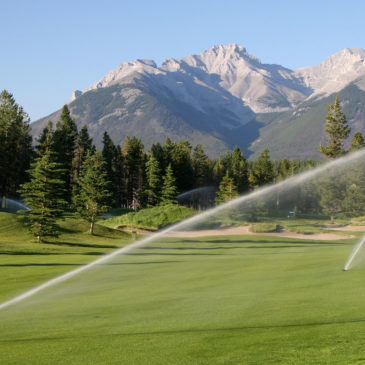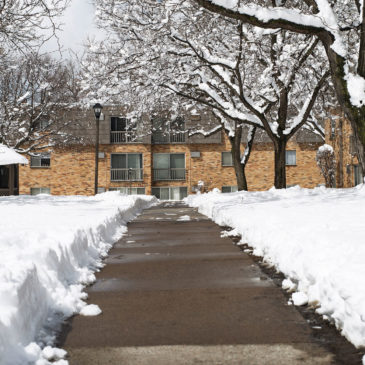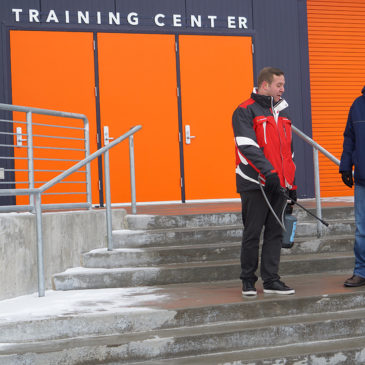The 2018 Farmer’s Almanac, which published in mid-August, predicts cold temperatures and above-average precipitation from the Great Lakes to the Northeast U.S.: “Snowier-than-normal conditions are expected,” the annual periodical predicts in its famous long-range weather forecast.
Even if you doubt the veracity of this 200-year-old publication, the fall season’s arrival brings with it one certainty: it is “prep time” for snow and ice removal, meaning now is the time to investigate the array of de-icing materials to ensure the greatest possible efficacy at the lowest possible cost.
Retail and restaurant business managers must consider how to de-ice areas requiring careful attention: wheelchair ramps, wider sidewalks and decorative — sometimes delicate — stone or other custom walkways — while being mindful of de-icers’ impact on metals in light fixtures and railings as well as nearby plant life. And, understandably so, retailers and restaurants are increasingly unwilling to accept stained and damaged floors and carpeting due to de-icing material being tracked into their establishments.
As we all know, preventative action is much more cost-effective than restorative efforts. So, here are the five key performance criteria we believe retailers and restaurants need to consider when evaluating de-icing materials:
- Speed of melt: While chloride-based granular de-icers take a minimum of 3 to 5 minutes to achieve an acceptable melt — and as much as 10 minutes — potassium formate quickly and reliably removes thin layers of ice and prevents new snow and ice from accumulating. In fact, one particular liquid de-icer has a speed of melt of about 30 to 50 seconds. With this product, the freezing point is reduced to approximately minus 63 degrees Fahrenheit (minus 53 degrees Celsius).
- Potential for tracking residue on carpeting and floors: Focus on what we call the “DMZ” zone outside your establishment; 90% of granular ice melt tracking on floors and carpets is the result of pedestrian traffic within the first 15 feet of the building entrance. When tracked into a store or restaurant, sodium chloride granular de-icers leave a white residue that can dull the finish of floors and fade the color of carpets. Calcium and magnesium chloride-based products coat floors with an oily, slippery residue that damages wax and urethane finishes, posing a safety risk to employees and visitors. A neutral pH formulation is designed to eliminate tracking, reducing near-term labor costs associated with manual cleaning, estimated at $50 per entrance per day, according to the International Sanitary Supply Association’s Clean Management Institute. In the long term, this reduces the need for full strip and re-coats, a significantly higher expense.
- Eco-friendliness and non-corrosivity: Calcium, sodium and magnesium granular chloride products are all hydroscopic, meaning they draw moisture from the atmosphere. Such materials are harmful to pets if swallowed, and certain chloride-based products like calcium chloride can seriously burn the paws of animals. In addition, chlorides will dehydrate turf and ornamentals and cause desiccation. If leached into waterways, they reduce the available oxygen levels, leading to the death of fish and aquatic plants. And, chlorides are corrosive to metals and, to varying degrees, to concrete and will reduce the functional life of structures such as railings and doors. Look for a liquid de-icer that is 100% chloride free and is readily biodegradable. It is safer for pets, plants, metals and concrete.
- Ease of application: Ease and speed of application combined with reduced transport and loading costs make using liquids extremely attractive from a labor perspective. Using granular products can be very labor intensive, slowing the application process and negatively impacting safety in high-traffic pedestrian areas. In many areas, such as stairs, applicators have to carry heavy bags, spreading material by hand. In larger areas and walkways, push spreaders may be utilized. But, liquid applications are far more efficient. Liquid tanks fill very quickly, and today’s liquid applicator (i.e. spray) technologies are accessible and easy-to-use, providing for very precise application rates.
- Cost-efficiency: If a liquid de-icer doesn’t require much actual liquid to produce an adequate melt, and is fast and easy to apply, it makes for a more cost-effective product than many granular ones. Most users will achieve a lower application cost per 1,000 square foot with this liquid de-icer than with granular de-icers. And, because the liquid achieves a melt three times more quickly than granular products, it creates a longer-lasting and safer walking surface.
As a retail or restaurant business manager, you know the primary reasons to clean: appearance; health and human safety; and asset preservation. When it comes to preparing for and cleaning during a snow event, you can now accomplish all three.



